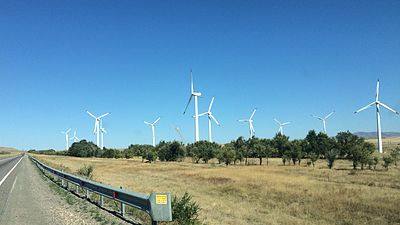The impact of wind power plants on birds is the subject of many foreign and domestic studies.
The main types of negative impact of wind power on avifauna include:
• the possibility of fatal collisions with elements of windmills (mortality from collisions with wind power plants is only 0.01% – 0.02% of all bird deaths);
• direct habitat loss and fragmentation and transformation;
• changing land use patterns;
• creating a barrier effect – changing the route.
From the point of view of impact on livestock, the negative impact of wind farms was not found. The use of grazing land for grazing is common practice. Moreover, turbine towers are a source of shade for animals.
The impact of wind power plants on chiropterofauna (bats) covers the following problems:
– destruction or disturbance of wintering and nesting colonies;
– the intersection of bat flight routes;
– prevention of the use of hunting grounds;
– risk of collision.
Studies commissioned by the Bonneville Administration in the United States found that bat populations migrating at the end of summer and autumn are more vulnerable to collisions with wind power plants, rather than bats inhabiting areas adjacent to wind turbines.
Acoustic effect
Wind turbine is the source of two types of noise:
1) mechanical noise generated by the gear wheel and the generator;
2) aerodynamic noise generated by rotating rotor blades, the intensity of which depends on the speed of rotation of the blades (the so-called tip rotation speed).
Thanks to advanced insulation technology, mechanical noise was limited to lower than aerodynamic noise in currently used turbine models. This is also due to the fact that the level of radiated mechanical noise does not increase with an increase in the size of the turbine at a rate that is observed in the case of aerodynamic noise.

Measurements carried out by the National Institute of Hygiene showed that the sound intensity is at the level of 100–105 dB, under the wind turbine itself – 50 dB, and at a distance of 500 meters it does not exceed 35 dB. It was also found that in practice the sounds of such intensity are not audible, because they are mixed with the noise of the wind and the natural environment.
Infrasound Effect
Wind power plants, due to the nature of the work and the requirements for adequate wind energy, are undoubtedly also a source of infrasonic noise, which, according to many popular opinions, reaches high levels and poses a threat to the environment. Infrasound can spread in the environment even at considerable distances from sources. The main way of perceiving infrasound is the receptors of human vibration sensations. The energy accompanying the infrasound can cause the resonance of the internal organs of a person. Measurements made led to the conclusion that the work of wind farms is not a source of infrasound at levels that may threaten human health.
Due to the lack of criteria for assessing infrasonic noise in the natural environment, criteria at the workplace were used. At a distance of 500 m from the turbine tower, the measured levels of infrasound were close to background levels.
In response to numerous public presentations on the potential negative impact of wind power plants, in particular noise and infrasound, which they emit on human health, the American Wind Energy Association and the Canadian Wind Energy Association created an international interdisciplinary research group in 2009. The group consisted of independent experts in the field of acoustics, audiology, medicine and health care.

The task of the group was to review the most up-to-date literature on the potential negative impact of noise generated by wind power plants on human health and to develop on its basis a comprehensive and public information document on this issue. The result of the group’s work is a report published in December 2009, entitled “The Sound and Effect of a Wind Turbine on Health. Expert panel overview. “The authors of the report have the following observations and come to the following conclusions:
1. Vibrations of the human body caused by the sound of a resonant frequency (that is, the frequency causing an increase in the amplitude of oscillations of the system with which the sound interacts) occur only in the case of very loud sounds. Given the level of noise produced by wind power plants, this does not apply to such a phenomenon.
2. Noise produced by wind power plants does not pose a risk of impairment or loss of hearing. Such a phenomenon can be encountered only when the sound pressure level exceeds 85 dB. The noise emitted by wind power plants does not exceed this sound pressure limit.
3. Experiments have shown that infrasound emitted at a level from 40 to 120 dB does not have a harmful effect on health.
4. The negative impact of wind power plants on the health and well-being of people in many cases is due to the so-called nocebo effect (the opposite of the placebo effect). Anxiety, depression, insomnia, headaches, nausea, or problems with concentration are common symptoms in every person, and there is no evidence that the frequency of their occurrence is clearly increasing among people living in close proximity to wind power plants. The effect of Nocebo unites the onset of symptoms of this type, not with a potential source of sensation of such discomfort (in this case with a wind power plant), but with a negative attitude towards it and rejection of its presence.


